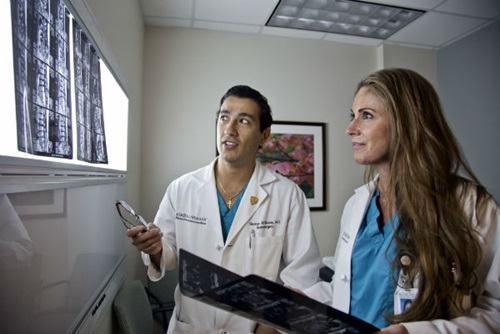 Cervical discectomy and fusion is a minimally invasive procedure that is performed to relieve pressure on one or more nerve roots or on the spinal cord in the cervical (neck) region of the spine. It is commonly used to treat severe pain that is caused by a ruptured or herniated disk, cervical degenerative disk disease, cervical spondylosis and cervical stenosis. Cervical discectomy and fusion may be recommended when severe neck pain is not resolved by more conservative therapies such as physical therapy and medication.
Cervical discectomy and fusion is a minimally invasive procedure that is performed to relieve pressure on one or more nerve roots or on the spinal cord in the cervical (neck) region of the spine. It is commonly used to treat severe pain that is caused by a ruptured or herniated disk, cervical degenerative disk disease, cervical spondylosis and cervical stenosis. Cervical discectomy and fusion may be recommended when severe neck pain is not resolved by more conservative therapies such as physical therapy and medication.
When a disk ruptures, either by a sudden injury or over time with age, the jelly-like center of the disk can “bulge” through and create pressure on the nerve root or cause painful bone spurs. This pressure can sometimes cause severe pain, weakness, numbness and tingling in the neck, arms and even the legs that can interfere with a patient’s quality of life. Surgeons affiliated with Memorial Hermann are among the most experienced in the nation, performing more than 500 procedures annually.
About the Procedure
During the procedure, the patient is on his or her back while the surgeon removes the offending disk to alleviate the pressure on the nerve and/or nerve root. A fusion surgery accompanies the disk removal in order to stabilize the spine where the disk was removed. The surgeon makes a small incision in the front of the neck to access the spine, removes either a portion of the disk or the entire disk if necessary, as well as any fragments or bone spurs that are causing pressure.
A bone graft from either a cadaver donor or from the patient’s hip is then inserted into the open space, where it will ideally fuse to the surrounding vertebrae and stabilize the spine. Sometimes, metal plates are added for further stability. It typically takes several weeks or months for the vertebrae to completely fuse together.
Cervical Discectomy and Fusion Recovery
Once surgery is complete, the patient will remain in the hospital for monitoring and treatment of postsurgical pain with medication. Most patients are encouraged to begin walking in the hospital within a few hours of surgery once they have recovered from the anesthesia. It is normal for continued pain immediately after surgery, particularly around the incision, and as the inflammation around the offending nerve root slowly decreases. Patients are typically discharged within one to three days, and should gradually increase the amount of walking every day, trying to do a little more each time.
Discomfort is normal after surgery, but pain is a sign that the body needs to stop and rest. Recovery times vary for every patient, but on average, patients recover within four to six weeks.
Contact Us
Please fill out the fields below, and we will contact you.